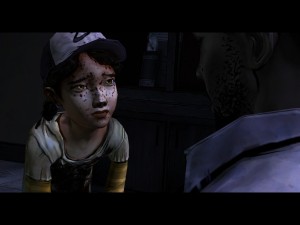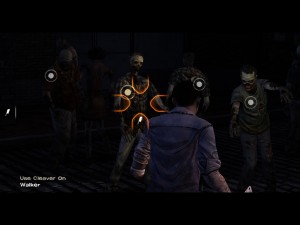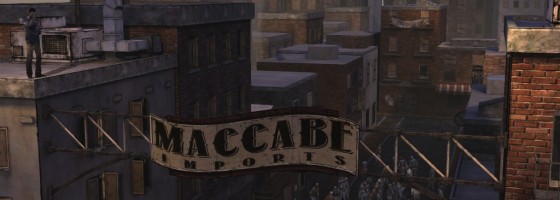For the week of Thanks Giving, Telltale Games released the final part of their five part season of The Walking Dead. With that, Telltale’s experiment with choose your own adventure story telling came to an end.
The episodes evolved over the course of the series and after seeing the final credit roll, I can say that The Walking Dead is both Telltale’s best game yet, and their worse.
This post will be spoiling aspects of all five parts of The Walking Dead and is meant for people who have already finished it.
A Story of Love and Lost:
Let’s start with what worked in The Walking Dead: the story. The plight of Lee and Clementine was one of the most well written game stories I’ve seen in a long time. And I would be surprised if voice actors Dave Fennoy and Melissa Hutchinson didn’t receive any kind of awards for their stellar performance as Lee and Clementine respectively.
The writing did a great job of fleshing out the characters and keeping it consistent. Kenny who served as both Lee’s friend and in some cases antagonist always put survival and family above anything else. It was hard to find a place where a character would react completely different to their personality due to the designer’s whim.
“This is where the debate over The Walking Dead divides gamers: What’s more important, having a story personalized by the player, or the gameplay?”
Episode 4 is the most interesting in terms of choices for the player as they not only have the usual screen showing what they did, but also who would join Lee for the final chapter. The affect between episode 4 and 5 is the biggest in the whole series and the one most players will likely remember the most.
I know some people would argue the death of a character in episode 3 based on who you saved in episode 1 was also memorable. But my problem with this was that it felt completely forced and seemed more like a way to narrow the ancillary characters down for the rest of the series. While introducing a few more that would stay with you and replace those that were gone.
The writing as a whole definitely improved as the series went on. Once again the focus on Lee and Clementine helped pull the player in, and took a story about surviving the zombie outbreak and turning it into a story about redemption and parenthood.

The player’s relationship between Lee and Clem grew just as much as theirs did. Making the final episode that much sadder
The final scene and choice of episode 5 is arguably one of the most emotional scenes we had in a video game in a long time.
And while you could argue that we were going to end up there eventually, the path the player took with these characters made this scene all the more emotional.
Now while the story of The Walking Dead got progressively better, things can’t be said about the gameplay.
Shambling Along:
The other half of an adventure game is the gameplay and this is where The Walking Dead quite frankly falls on its face. As we moved through each episode, the quality and frequency of the puzzles degraded. The problem with talking about puzzle design in adventure titles is that there is a fine line between making a puzzle that challenges the player, and one that requires MacGyver logic to solve.
For the first half of the season, the designers did a good job of keeping the puzzles interesting, while making them logical. You had to scavenge for items to make patch work fixes for instance. Two of my favorite puzzle segments were in episode one and episode three.
The first one was when you had to use stealth and a variety of items to take out walkers in a motel without alerting them to your presence. The other was when you had to figure out how to start the train.
However, these moments of puzzle solving degraded as we moved into the second half of the season. Episodes 4 and 5 had very few puzzles and were more focused on quick time event sequences and exposition. The whole bad-ass ninja lady segment felt out of place to me as she seemed more at home in Assassin’s Creed then The Walking Dead. Making episode 4 seen more action packed then it really was.
For having such an emotional payoff, episode 5 was a huge let down gameplay wise. As there was just one puzzle for you to solve (the final scene) and the rest was just exposition and QTEs.
After the game made such a big deal about your choices and who would come with you, I was expecting them to have a bigger impact on how the episode played out.

Zombie killing, which was a part of puzzle solving in the earlier chapters, just became resigned to QTE segments at the end.
But once again there was no pay-off other then exposition about the other players. Granted people who enjoyed the story felt rewarded, but for people invested in their choices, it was a different story.
The thing about The Walking Dead was that many of us going into it thought that the game was a “Choose Your Own Adventure” styled title with how your choices had an effect. However, your choices while personal, did not affect the world around you.
People who were destined to die were going to die regardless of how you played. Granted the game at the end did hint at different fates for several characters, but I played the game picking all the choices around saving people and they still ended up dying, so I don’t know if you could monumentally change things.
With the notion of having the game grow by your choices, I was expecting the game to take different turns. But the main events of the game will happen the same way every time regardless of your interactions. In episode 2 there is a part where you have to decide how to split the remaining rations of food up, a great moment of the game, sullied by the fact that it doesn’t change anything.
This is where the debate over The Walking Dead divides gamers: What’s more important, having a story personalized by the player, or the gameplay?
In the end, regardless of where your opinion lies, Telltale definitely knocked it out of the park with The Walking Dead. Not only succeeding with a licensed IP, but also continuing to prove the merits of episodic games.At this point, it will be interesting to see where Telltale will take the series next: Either working on the gameplay or further enhancing the player’s choices on the story. Regardless, I and many other gamers can’t wait.


